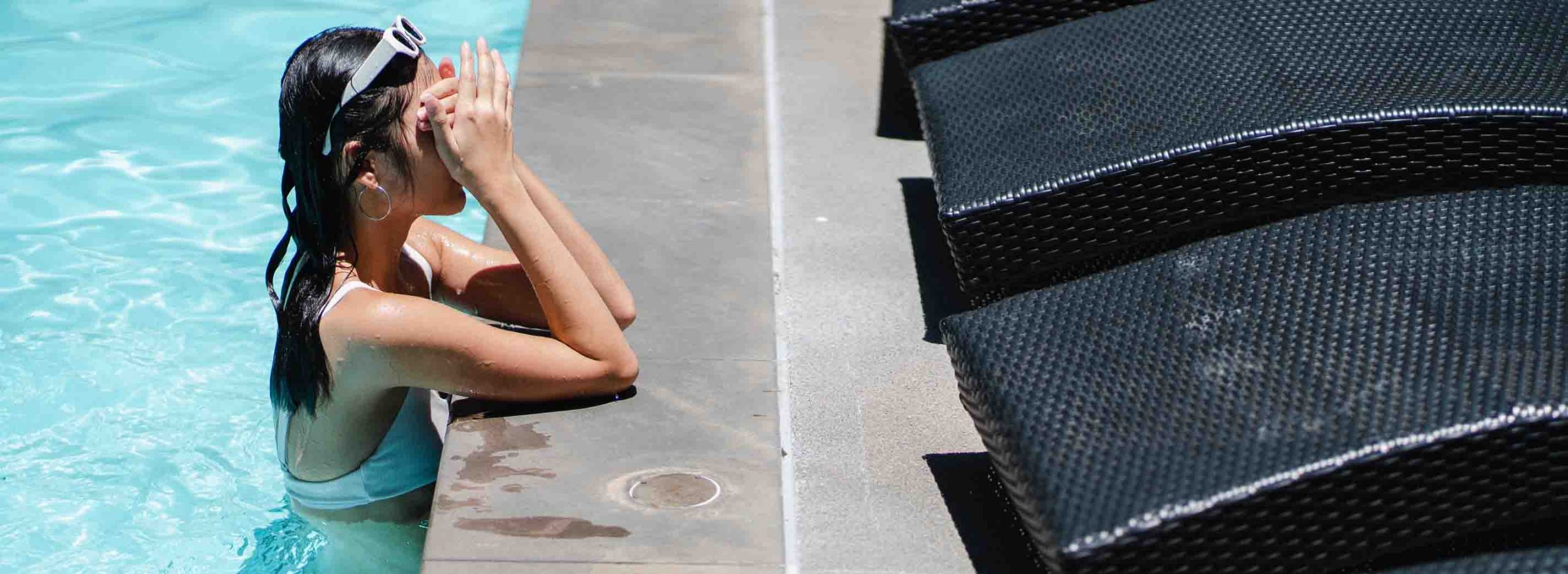Here Is How You Can Protect Your Pool From Lotions Such As Sunscreen and Tanning Oils
Tanning oils and sunscreen lotions go a long way in keeping people safe from the sun's UV rays on the sunniest summer days. However, the same products can have several negative effects on your swimming pool.
In this post, we’re going to tell you all about the damage that sunscreen, tanning oils, and other lotions can do to your concrete, vinyl liner, or fibreglass pool. So, without any further delays, let’s get right into it!

The effects of lotions on pool water
Lotions are oily substances, and you probably already know oil and water don’t mix. So, when you enter a swimming pool with a thick layer of oil on your body, there’s a high chance that the oil will slide off and float to the water’s surface. The most evident effect that this has on the pool water is the oily rainbow-like appearance. Not only will the water feel slimy, but there’s also a possibility that on its way up to the surface, the oils will collect dirt and grime. This will make the water look and feel dirty – not what you’d want, right?
There’s also the chance that the excess oils will interfere with the pool water chemistry. Maintaining the pool water chemistry is vital for keeping the swimming pool safe. It involves a variety of elements such as pH, total alkalinity, chlorine, total dissolved solids (TDS) and calcium hardness – all of which play crucial roles in maintaining water quality. So, all in all, it’s fair to say that lotions such as sunscreen and tanning oils aren’t any good for your swimming pool’s water. But does this mean that you can’t apply any lotion before you enter the pool on a hot summer’s day?

Tips to minimize the effects of oily lotions on swimming pools
Spending time in the sun with some oil on the body can help you relax and unwind before you hit the water. However, to keep the oil’s effects at bay, we recommend putting into practice the following tips:
Install an outdoor shower
Have you ever been to a public pool at a resort? If you have, you’d have probably noticed signs that ask swimmers to take a shower before they make their way into the pool. Why do you think that’s the case? Well, the reason why public pools ask swimmers to do this is simple – showering before entering the pool ensures the removal of excess oils. Simply put, doing this will keep the oils from the lotions from making their way into the pool water. That’s why we recommend you install an outdoor shower. It doesn’t have to be anything fancy – simply being functional will do. And, of course, ask both your family and your guests to wash their bodies well before they enter the pool.
Add algaecide and/or enzyme treatments
Even if a ton of oil gets into your swimming pool, it doesn’t mean you have to flush all of the water out. There are some products like enzyme treatments and algaecides that will help you deal with the oil. While enzyme treatments remove oils from water, algaecides can help the oil to clump together, which makes it easy for you to remove the oil manually. If you’re using an algaecide, give it some time to collect the oils. Use a skimmer (preferably with a fine mesh and a long handle) to skim the water surface manually for removing the collected oils.
Perform routine filter cleaning
Irrespective of the type of filter your pool has, make sure that you clean it regularly. Both sand and cartridge filters can be affected by high oil content. As a result, your pool water may start to appear greenish with black oil deposits – a truly ugly sight. The best way to deal with this issue is to clean your pool filter at least once every week (if you’re a frequent pool user). If you have a cartridge filter, replace the cartridge every week for the best results. The point of this filter cleaning exercise is simple – to eliminate filter inefficiencies brought about by excessive exposure to oil content.
Apply lotions properly by following use directions
The problem with most people who enter swimming pools with an absurd amount of oil on their bodies is that they don’t apply lotions the way they’re supposed to. If you look closely at the directions mentioned on the packaging, you’ll find that users are asked to wait 20 – 30 minutes before exposing their skin to water post-application. This waiting period allows the skin to absorb most of the oil content, which drastically reduces the oil quantity that slides off your body into the pool. Also, when applying the products, make sure that you rub them thoroughly. Casually applying them leads to the use of more oil than necessary.
Check pool water chemistry regularly
Even though the previous tips will significantly lower the amount of oil that enters your swimming pool, the fact is that some amount will still be making its way into the water. While minimal oil content won’t make too much of a difference, over time, the oil content in the water may increase. To track how much the oils are affecting the pool water, it’s best to conduct regular pool water chemistry checks. Through these checks, you can find out the elements of the pool water chemistry that have been disturbed by the oil content. For example, the accumulation of oil may reduce chlorine levels, which you’ll get to know about through a pool water chemistry check. You can correct the situation by adding more chlorine.
Click here for some tips on how to save time cleaning your pool!

Conclusion
When oily lotions get inside the water of your vinyl liner, concrete, or fibreglass pool, its water quality may get severely deteriorated. That’s why it’s essential that you adopt the tips that we shared with you in this post. Putting them all into practice will ensure the safety of not just your swimming pool, but of all those people who want to have a relaxing time in it. So, we hope you learned a thing or two from this post. Here’s to a sweet summer experience in your backyard!


